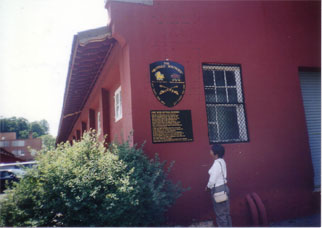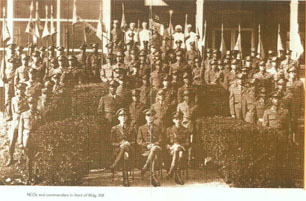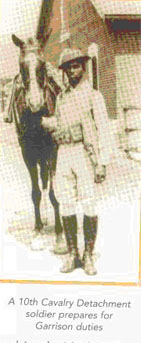Buffalo Soldiers at Fort Myer

Carmon W. Hicks pictured at Buffalo Soldier marker, Ft. Myer
On May 22, 1891, Troop K of the 9th U.S. Cavalry left Fort Robinson, Nebraska by rail bound for Fort Myer and arrived on May 25, 1891. Upon arrival, the 69 men and three officers received 55 serviceable horses and began training. Troop K performed routine garrison duties with other Fort Myer Cavalry units. Garrison duties consisted of drills, parades, practice and still more practice, which differed from one season to another. If the weather proved inclement, there was a riding hall tucked away in one corner of the post in which the drills and shows could be performed.

In August 1893, Troop K served as escort to President Grover Cleveland during a special parade. Cavalry soldiers from Fort Myer were more than show soldiers; they were good saddle riders and complete masters of their horses. They practiced bareback on dead-level heats and jumped hurdles of varying heights that were designed to provide mastery and survival in the field. The soldiers were professionals who, on a moment’s notice, could draw up in a line in front of the White House ready for either action of parade. On October 3, 1894, the 9th U.S. Horse Cavalry returned to Fort Robinson.

In 1916, the 10th Cavalry was part of General Pershing’s expedition into Mexico. They remained on the southwest border during World War I, and in 1931 its squadrons were sent to support Army training at West Point Military Academy, New York; Fort Myer, Virginia; and Fort Leavenworth, Kansas. Machine Gun Troop of the 10th arrived at Fort Myer on October 15, 1941. They were housed in building 308 and their horse stables were located in buildings 306 and 307, adjacent to the barracks.

Soldiers from the 10th Cavalry who were later interviewed spoke of segregated facilities such as the dining hall, Post Exchange, and barber shop. Even though this era was characterized by discrimination and unfair treatment, the Buffalo Soldiers of the Machine Gun Troop worked hard to overcome the obstacles. Their exceptional performance and fine talents were displayed during parades and horse shows, as well as their routine duties conducting burials at Arlington National Cemetery.
During World War II, the Army staged an exhibit at the Washington Monument called “Back the Attack.” The Buffalo Soldiers performed daring maneuvers with glittering sabers and colorful uniforms to help sell war bonds. In addition to performing in parades and horse shows, they performed duties as saddlers, horseshoers, drivers for senior grade officers, housekeepers, groomsmen for senior officers, and prisoner escorts. The Machine Gun Troop was responsible for President Franklin D. Roosevelt’s horses which Mrs. Roosevelt rode daily.
